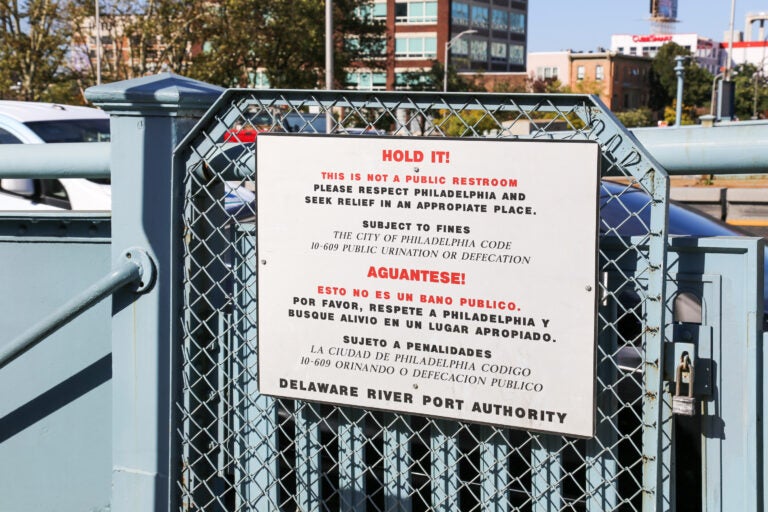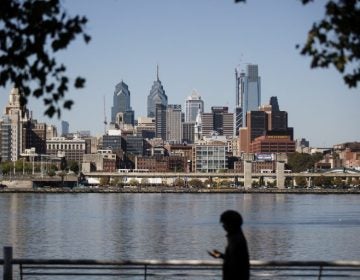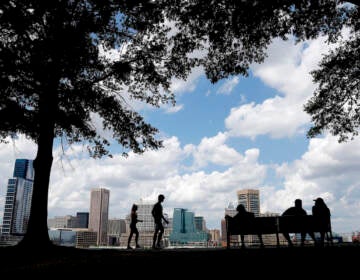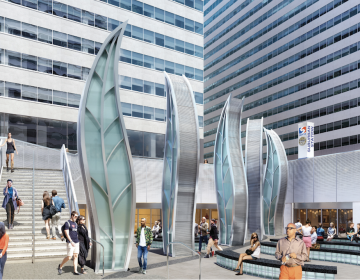Seriously, where are Philly’s public restrooms?
Public space writer Conrad Benner makes the case for public potties and talks to city officials about plans for a network of restrooms.
Listen 7:52
Signage telling people to "hold it" on the Philadelphia side of the Benjamin Franklin Bridge (Photo by Conrad Benner)
This is the first installment of Our Space, a new collaboration between author Conrad Benner, PlanPhilly, and WHYY’s News and Information Community Exchange. Our goal: to talk with Philadelphians about the spaces we share.
It’s a question you’ve likely asked yourself many times in your life while you’re out running errands, enjoying a public park, or doing anything really outside your home or work: Where is there a restroom around here? And if you’re in Philly, the answer to that question is complicated, especially during COVID. So let’s talk about it, the piece of critical public infrastructure that most of Philadelphia sorely lacks: public restrooms.
What do you do when you need a restroom in Philly? “Any restaurant that’s in a hotel, you just walk in, say ‘where the bathrooms at,’ and they’ll point them to you,” says Douglas King, a West Philly resident who’s worked in Center City’s hospitality industry. The people behind the front desk are usually pretty accommodating, he said.
When I put the question out on Twitter, a number of the other people also recommended walking into a business as confidently as you can and look for a restroom — something easier to do before the coronavirus saw many local restaurants close in addition to almost every coffee shop closing access to their facilities. But at the end of the day, private businesses do not have to let anyone use their restrooms — and the racial prejudice or other biases of any individual employee can ultimately rule this option out for large swathes of the population. Philadelphia learned this lesson in 2018 when a Starbucks manager called police on two Black men waiting in the Rittenhouse cafe for an acquaintance.
And what if you have children, who also need to go? Alyssa Bigbee is a Philadelphia mother and she describes Philly’s bathroom desert as “always a challenge.” “It’s literally my worst fear at this point,” Alyssa explained. “If we’re downtown and all of a sudden my son has to go to the bathroom, I know it’s about to be an adventure to find one.” She added that she usually will rush to a local coffee shop in the hopes they have a restroom, often having to buy something to use it if they do.
The frustration around Philly’s lack of public restrooms becomes something of a logistical nightmare for people like Alyssa, who travel around the city with babies or young kids. Or people who are pregnant. People who menstruate. People with various disabilities. People with diabetes or other health issues that cause the need for more frequent restroom breaks. Gender non-conforming people who should have access to non-gendered public restrooms. And the list goes on.
In fact, when looking at one of our city’s most vulnerable populations, folks who are unhoused, the lack of basic public infrastructure like restrooms can lead to what happened in 2019: a Hepatitis A outbreak. Yep, when people have no other option but to have bowel movements in the streets, the disease can spread.
And while Philly does have a few public restrooms at popular tourist destinations like those on Independence Mall or at City Hall, they were only open weekdays 9-5 before COVID shut them down completely. A few more in parks like Penn’s Landing or Fairmount Park are open a bit later into the evening but still not through all the hours that those places are super busy and full of Philadelphians. Meanwhile, you can forget about parks like Rittenhouse, Penn Treaty, Clark Park and popular shopping streets like Walnut, Chestnut and 52nd streets, Frankford and Passyunk avenues and Broad Street, all having no infrastructure of which to speak.
So what does offering no or limited public restrooms in bustling areas around the city create? “My God, there’s more facilities for dogs than there are for people,” exclaimed Dr. Melissa Dunphy. Melissa lives near Delaware Avenue under the Ben Franklin Bridge, and she told me that she and her doorbell camera regularly see desperate individuals finding a spot in front of her home to relieve themselves.
One solution to Philly’s lack of public infrastructure might be the Portland Loo, named after the Oregon city that commissioned the stainless-steel stand-alone toilet design. These public potties are about the size of a bus shelter and are intended for easy installation in a busy urban area. Best of all, they can be open 24/7, or for hours that make the most sense for the street or park. Keep in mind Portland is about half the size of Philly in population and wealthier as a city. They currently have 10 of these public bathrooms. Other cities are starting to install them too, Denver, San Francisco, and Boston among them.

Kensington’s toilet test and a plan for the future
In the fall of 2019, Philadelphia tested public toilets and sinks in Kensington, the solution to that Hepatitis A outbreak. According to Mike Dunn, a spokesperson for Mayor Kenney, those restrooms were widely used. Dunn said that as a result of the experiment, city officials engaged the community to consider longer-term options for public restrooms. And in response to COVID-19, the city has temporarily retained the restroom trailers in Kensington and added six portable toilets in Center City on Arch Street near Thomas Paine Plaza where the Frank Rizzo statue once stood.
The Kenney administration’s current focus is on getting restrooms to the people who need them most, which makes a ton of sense. The top criteria for considering the placement of any future restrooms in Philly centers on areas of the city with high populations of unsheltered individuals and those experiencing substance use disorder. Dunn mentioned that these possible future restrooms would be integrated with additional services, like referrals to connect people with resources to meet their basic needs: food, shelter, clothing, health care and treatment. And that’s a great and needed start, though there’s no timeline attached to these plans.
And as for a more general network of stalls that can offer Philadelphians and visitors alike relief when visiting parks, shopping districts, or other public spaces, there is currently no plan. My guess is that we’d need a lot more public pressure to make progress there. And let’s be frank, with the city’s budget blown by COVID’s economic hit, it might be hard to argue that building a better network of public restrooms is the most important thing to do right now. Even if each and every one of the million and a half of us Philadelphians need one several times each day.
Alas, for now, Philly, just avoid any puddles. And look the other way when someone inevitably goes on the street. Because, what else can we expect when there’s no public infrastructure?

Subscribe to PlanPhilly
WHYY is your source for fact-based, in-depth journalism and information. As a nonprofit organization, we rely on financial support from readers like you. Please give today.









